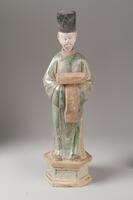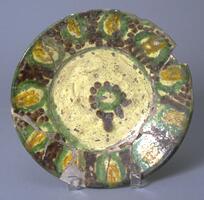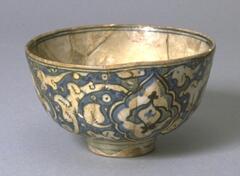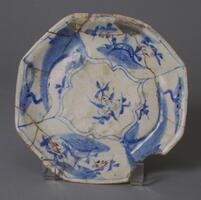16 UMMA Objects
16 UMMA Objects

Iranian (Iranian)
Bowl with abstract design, glazed in imitation of Chinese sancai ware
13th century
Museum Purchase
1957/1.55

Iranian (Iranian)
Plate with deep red-brown glaze spashed with yellow (cracked)
1600 – 1899
Museum Purchase
1957/1.98

Iranian (Iranian)
Shallow open box with three compartments, adorned with women's faces
19th century
Museum Purchase
1957/1.99

Chinese (Chinese (culture or style))
Male Attendant
1368 – 1644
Gift of Jiu-Hwa Lo Upshur
2009/2.105A&B
![Dark brown glaze has been dripped over the pot from above, allowing it to flow unevenly so that the lighter clay body shows through in an unpredictable pattern. The jar appears rounded in gradations, and has a small circular lid, as well as base.<br />
<br />
This jar is made of white clay and coated with brown-black glaze. No glaze was applied to the inner surface of the lid or the rim of the jar with which the lid comes into contact. The shoulder is incised with a wave design, while an incised line also surrounds the upper part of the body. The glaze is well fused to form a glossy surface. The jar is almost intact.<br />
[Korean Collection, University of Michigan Museum of Art (2014) p.213] Dark brown glaze has been dripped over the pot from above, allowing it to flow unevenly so that the lighter clay body shows through in an unpredictable pattern. The jar appears rounded in gradations, and has a small circular lid, as well as base.<br />
<br />
This jar is made of white clay and coated with brown-black glaze. No glaze was applied to the inner surface of the lid or the rim of the jar with which the lid comes into contact. The shoulder is incised with a wave design, while an incised line also surrounds the upper part of the body. The glaze is well fused to form a glossy surface. The jar is almost intact.<br />
[Korean Collection, University of Michigan Museum of Art (2014) p.213]](/media/W1siZiIsIjIwMjIvMDkvMjQvNGoxczYwNTZmcV9kZWZhdWx0LmpwZyJdLFsicCIsInRodW1iIiwiMjQweDIwMCJdXQ?sha=f635a1b948d4c912)
Korean (Korean (culture or style))
Preserve Jar with Lid
1850 – 1899
Gift of Bruce and Inta Hasenkamp and Museum purchase made possible by Elder and Mrs. Sang-Yong Nam
2004/1.294A&B
![This brownish black bottle was made from porcelain clay coated in brownish-black glaze. The high-iron content of the glaze has given it a black shade. Sand has been removed from the clay, giving it a smooth texture. Coarse sand spurs were used during firing. The glaze is well fused and the surface is glossy. It remains intact and undamaged.<br />
[Korean Collection, University of Michigan Museum of Art (2014) p.212] This brownish black bottle was made from porcelain clay coated in brownish-black glaze. The high-iron content of the glaze has given it a black shade. Sand has been removed from the clay, giving it a smooth texture. Coarse sand spurs were used during firing. The glaze is well fused and the surface is glossy. It remains intact and undamaged.<br />
[Korean Collection, University of Michigan Museum of Art (2014) p.212]](/media/W1siZiIsIjIwMjIvMDkvMjQvNzQ1dTMxY3N1Ml9kZWZhdWx0LmpwZyJdLFsicCIsInRodW1iIiwiMjQweDIwMCJdXQ?sha=9e1bc87f50c4be8a)
Korean (Korean (culture or style))
Nine-sided bottle
1850 – 1899
Gift of Bruce and Inta Hasenkamp and Museum purchase made possible by Elder and Mrs. Sang-Yong Nam
2004/1.296
![Bottle with a dish shaped mouth and coated with greenish-brown glaze. Glaze is oxidized in parts, creating a yellow-brown hue. Has cracks from firing process. The base is wide and flat and the neck is connected in a fluid curve.
<p>This is a bottle with dish-shaped mouth and applied with greenish-brown glaze, which is also referred to as “green celadon (nok-cheongja).” The greenish-brown glaze was oxidized in parts and turned brown, and it overall created a yellowish brown hue. This piece is not in perfect form as cracks formed in places during ring. Although the shoulder is angular, the neck is connected to the body in a fluid curve. The base is wide and flat. Many examples of this type of the bottle with dish-shaped mouth were excavated from the 10th-11th century Goryeo tombs.</p>
[Korean Collection, University of Michigan Museum of Art (2014) p.140]<br />
Bottle with a dish shaped mouth and coated with greenish-brown glaze. Glaze is oxidized in parts, creating a yellow-brown hue. Has cracks from firing process. The base is wide and flat and the neck is connected in a fluid curve.
<p>This is a bottle with dish-shaped mouth and applied with greenish-brown glaze, which is also referred to as “green celadon (nok-cheongja).” The greenish-brown glaze was oxidized in parts and turned brown, and it overall created a yellowish brown hue. This piece is not in perfect form as cracks formed in places during ring. Although the shoulder is angular, the neck is connected to the body in a fluid curve. The base is wide and flat. Many examples of this type of the bottle with dish-shaped mouth were excavated from the 10th-11th century Goryeo tombs.</p>
[Korean Collection, University of Michigan Museum of Art (2014) p.140]<br />
](/media/W1siZiIsIjIwMjIvMDkvMjQvNHo2YXR2OWI0X2RlZmF1bHQuanBnIl0sWyJwIiwidGh1bWIiLCIyNDB4MjAwIl1d?sha=7240de9ca3dffd3f)
Korean (Korean (culture or style))
Greenish-brown-glazed Stoneware Bottle with Dish-shaped Mouth
13th century
Gift and partial purchase from Bruce and Inta Hasenkamp, purchase with funds from Elder and Mrs Sang-Yong Nam
2021/1.150
![The form of this bottle is unusual in that its body and neck are almost the same length. The glaze is partially oxidized, producing an orange tint, while the surface shows contamination by impurities and pinholes, and cracks are formed towards the foot. The bottle is glossy overall, but the glaze was unevenly applied and has run in some parts. The clay has a high kaolin content, and the bottle has thin, light walls. White porcelain of this kind was produced in Yanggu-gun, Gangwon-do, and Cheongsong-gun, Gyeongsangbuk-do.<br />
[Korean Collection, University of Michigan Museum of Art (2014) p.206] The form of this bottle is unusual in that its body and neck are almost the same length. The glaze is partially oxidized, producing an orange tint, while the surface shows contamination by impurities and pinholes, and cracks are formed towards the foot. The bottle is glossy overall, but the glaze was unevenly applied and has run in some parts. The clay has a high kaolin content, and the bottle has thin, light walls. White porcelain of this kind was produced in Yanggu-gun, Gangwon-do, and Cheongsong-gun, Gyeongsangbuk-do.<br />
[Korean Collection, University of Michigan Museum of Art (2014) p.206]](/media/W1siZiIsIjIwMjIvMDkvMjQvNDh2ZnMxbGl1Yl9kZWZhdWx0LmpwZyJdLFsicCIsInRodW1iIiwiMjQweDIwMCJdXQ?sha=70a5279c6cfabd63)
Korean (Korean (culture or style))
Buncheong ware bottle with globular body and funnel-shaped neck
1900 – 1950
Gift of Bruce and Inta Hasenkamp and Museum purchase made possible by Elder and Mrs. Sang-Yong Nam
2004/1.295
Loading…




